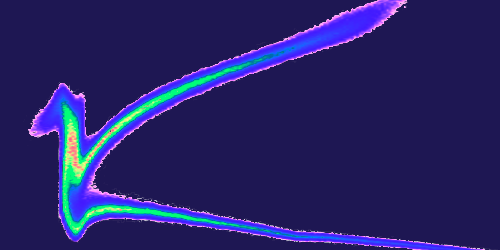Attosecond X-Ray Flashes
To capture the fast motions of electrons that govern many chemical and magnetic processes, researchers will require flashes of x rays with durations in the attosecond (as) range. Attosecond pulses are typically produced from the high harmonics of infrared laser photons, but at x-ray wavelengths, such pulses tend to be too weak to be useful. Yuantao Ding of the SLAC National Accelerator Laboratory, California, and colleagues have taken a more direct approach and used SLAC’s x-ray free-electron laser (XFEL)—the Linac Coherent Light Source (LCLS)—to generate 200-as x-ray pulses. Up to now, the shortest pulses from XFELs have been several femtoseconds long.
In XFELs, electron bunches are first accelerated in radio frequency (rf) cavities and then compressed in magnetic “chicanes,” which deflect an electron’s trajectory based on its speed. Finally, the bunches are made to zigzag through a magnetic device known as an undulator, in which they emit x-ray pulses of femtosecond duration. In 2014, a collaboration that included the LCLS group proposed a way to tune the cavities and chicanes to achieve much shorter pulses. Instead of generating the shortest possible electron bunches, the modified devices would produce bunches with a high density of electrons near the front of the bunch followed by a lower-density tail. In the undulator, only the high-density part would have sufficient intensity for lasing, resulting in an isolated, few-hundred-attosecond x-ray pulse.
The researchers have now brought their proposal to fruition. By optimizing the voltage of the rf cavities and the charge of the electron bunches, they were able to generate 200-as pulses at 5.6 and 9 keV. The scheme leverages existing XFEL hardware and works for different energy ranges, so it could be implemented without complex upgrades at current XFEL facilities.
This research is published in Physical Review Letters.
–Matteo Rini
Matteo Rini is the Deputy Editor of Physics.





